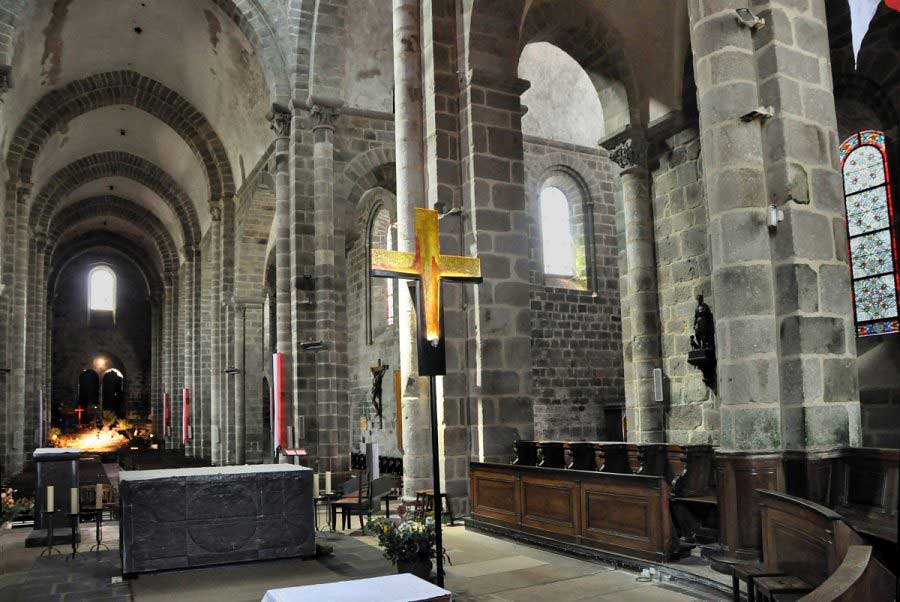
The city of Le Dorat has lived through several eventful periods in history. Assaulted by the Black Prince - Prince of Wales - in 1356, the city also suffered much damage during the Wars of Religion.
Of its past as a fortified town, Le Dorat has kept a superb 15th century shepherd's gate, the only one in the whole of Limousin, which certainly owes its name to the fact that it was used by herdsmen.
Le Dorat is also home to one of the most important Romanesque monuments in the Limousin, the Collegiate Church of Saint Peter from the 11th and 12th centuries.
Every seven years, Le Dorat celebrates the ostensions, ceremonies of veneration of the relics of the holy protectors of the City, Saint-Israel and Saint-Théobald .
The collegiate church of Saint Peter
The collegiate church of Saint-Pierre or church Saint-Pierre-ès-Liens du Dorat is a pure architectural masterpiece of the 12th century. This imposing Romanesque church, 77 metres long and 39 metres at the transept, is built in grey granite with a Latin cross plan. All the archetypes of the Limousin Romanesque of this period for a large church can be found here: the ambulatory, the radiating chapels, the supporting crypt, the Limousin bays, serpentine capitals, poly-lobed Limousin portals... It is a homogeneous building except for the 15th century fortifications, hence its massive character.
It was classified as a historical monument in 1846.
A rich furniture
- The large Carolingian baptismal basin at the end of the nave, made of monolithic pink granite and rectangular in shape, with its lions sculpted in a flattened shape.
- The organs: the instrumental part of this choir organ is the work of Aristide Cavaillé-Coll, and was classified as a Historic Monument in 1978.
- The altar, the work of Philippe Kaeppelin (1973), is placed on a paving comprising fifty slabs of granite with lime joints. It consists of four extremely resistant lathed wooden frames, covered with a thick sheet of lead beaten into the stone. It is surmounted by a hanging cross, and nearby is an oak Christ covered with copper foil, made by the sculptor Gubellini (1961).
- The 17th-century Châsses of Saint Israel and Saint Theobald, patron saints of Dory, in gilded wood, resting on granite stelae with a wrought-iron surround, with enamels by Georges Magadoux (1967) in medallions.
- Two stained glass windows, installed in the chapels of the transept in 1870. Until then, the 60 windows were closed by blind walls or simple panes of glass. From 1881 to 1885, 36 other stained glass windows were installed.
- A plaster statue of St. Peter, with a bronze right foot, on his throne, blessing the faithful with a gesture of the right hand.
- The fifteen Stations of the Cross: in terracotta, distributed on the walls of the side aisles. This Stations of the Cross is the work of Felix Oudin (1962).
A bit of History...
According to tradition, to commemorate a victory near Civaux, Clovis built an oratory in which he installed clerics. This tradition could explain the date 501 engraved on the tympanum of the portal of the main façade. The oratory became an abbey, destroyed by fire in 866 and restored in 987 by Boson, Count of the March, who instituted regular canons. Tradition reports that the present church was built by the second abbot, Drutus Mortemard, who made a trip to the Holy Land.
On January 27, 1130, the bodies of St. Israel and St. Theobald were raised from the ground and carried in procession into the collegiate church. The relics were then placed on the altars to be venerated by the faithful, before being lowered into the crypt in two granite tombs.
Until 1170, work campaigns followed one after the other, adding the nave, the façade and the transept bell tower.
In the 15th century, Abbot William the Hermit raised the city walls and fortified the building. A corbelled parapet walk crowned the walls of the collegiate church. The Huguenots seized Le Dorat in 1567 and looted the furniture of the church.
In the 19th century, the main part of the defensive system was suppressed, the parapet walk, crenellations and machicolation. As a result, the collegiate church, as we see it today, is almost the image of the building created in the 12th century.
https://www.patrimoine-histoire.fr/P_Limousin/LeDorat/Le-Dorat-Collegiale-Saint-Pierre.htm
Translated with www.DeepL.com/Translator
(free version)





